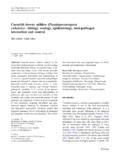Transcription of Evaluation of different detection methods of biofilm ...
1 ORIGINAL ARTICLE305 Evaluation of different detection methods of biofilm formation in the clinical isolatesAuthorsAfreenish Hassan1 Javaid Usman2 Fatima Kaleem1 Maria Omair3 Ali Khalid1 Muhammad Iqbal41 MPhil Microbiology, Department of Microbiology, National University of Sciences and Technology (NUST), Islamabad, Army Medical College, Rawalpindi, Pakistan 2 Professor of Pathology, Department of Microbiology, NUST, Islamabad, Army Medical College, Rawalpindi, Pakistan 3 FCPS Microbiology, Department of Microbiology, NUST, Islamabad, Army Medical College, Rawalpindi, Pakistan 4ST, Senior Technician, Department of Microbiology, NUST, Islamabad, Army Medical College, Rawalpindi, PakistanSubmitted on: 01/03/2011 Approved on: 05/03/2011 Correspondence to:Afreenish HassanDepartment of MicrobiologyNational University ofSciences and Technology,Islamabad, Army Medical College, Rawalpindi, declare no conflict of interest. 2011 Elsevier Editora Ltda.
2 All rights : Microorganisms growing in a biofilm are associated with chronic and recurrent hu-man infections and are highly resistant to antimicrobial agents. There are various methods to detect biofilm production like Tissue Culture Plate (TCP), Tube method (TM), Congo Red Agar meth-od (CRA), bioluminescent assay, piezoelectric sensors, and fluorescent microscopic examination. Objective: This study was conducted to compare three methods for the detection of biofilms . Method: The study was carried out at the Department of Microbiology, Army Medical College, National University of Sciences and Technology, Pakistan, from January 2010 to June 2010. A total of 110 clinical isolates were subjected to biofilm detection methods . Isolates were identified by standard microbiological procedures. biofilm detection was tested by TCP, TM and CRA. Antibiotic suscep-tibility test of biofilm producing bacteria was performed by using the Kirby-Bauer disc diffusion technique according to CLSI guidelines.
3 Results: The TCP method was considered to be superior to TM and CRA. From the total of 110 clinical isolates, TCP method detected as high, 41% mod-erate and as weak or non- biofilm producers. We have observed higher antibiotic resistance in biofilm producing bacteria than non- biofilm producers. Conclusion: We can conclude from our study that the TCP method is a more quantitative and reliable method for the detection of biofilm forming microorganisms as compared to TM and CRA methods , and it can be recommended as a general screening method for detection of biofilm producing bacteria in laboratories. Keywords: biofilms ; bacteria; anti-bacterial are defined as microbially derived ses-sile communities characterized by the cells that are irreversibly attached to a substratum or to each other. They are embedded in a matrix of extracellular polymeric substances (EPS) they have produced, and exhibit an altered phe-notype with respect to growth rate and gene Within a biofilm , bacteria com-municate with each other by production of chemotactic particles or pheromones, a phe-nomenon called quorum Availability of key nutrients, chemotaxis towards surface, motility of bacteria, surface adhesins and pres-ence of surfactants are some factors which in-fluence biofilm Microorganisms growing in a biofilm are intrinsically more re-sistant to antimicrobial agents than planktonic cells.
4 High antimicrobial concentrations are required to inactivate organisms growing in a biofilm , as antibiotic resistance can increase 1,000 According to a publication by the National Institutes of Health, more than 80% of all infections involve biofilms are as-sociated with many medical conditions includ-ing indwelling medical devices, dental plaque, upper respiratory tract infections, peritonitis, and urogenital Both Gram-positive and Gram-negative bacteria have the capability to form biofilms . Bacteria commonly involved include Enterococcus faecalis, Staphylococcus aureus, Staphylococcus epidermidis, Streptococ-cus viridans, Escherichia coli, Klebsiella pneu-moniae, Proteus mirabilis and Pseudomonas There are various methods to detect biofilm production. These include the Tissue Culture Plate (TCP),7 Tube method (TM),8 Congo Red Agar method (CRA),9 bio-luminescent assay,10 piezoelectric sensors,11 and fluorescent microscopic BJID-4-JUN ARTE 30528/07/11 13:30306We screened 110 organisms by three different methods , which could be used in a routine clinical laboratory, for determining their ability to form study was conducted to detect biofilm forming microor-ganisms isolated from clinical specimens by three different methods (TCP, TM, CRA) and to compare these methods for biofilm AND METHODSP lace and duration of the studyThe study was conducted at the Department of Microbiol-ogy, Army Medical College, National University of Sciences and Technology, Pakistan, from January 2010 to June of the isolatesA total of 110 clinical isolates were subjected to biofilm de-tection methods .
5 Organisms were selected on the following criteria: those isolated from the pus, intravenous and urinary catheter tips, urine, sputum and nasobronchial lavage speci-mens, and those showing increased resistance to commonly available antibiotics by Kirby-Bauer disc diffusion method. Urinary catheter tips, intravenous catheter tips, nasobron-chial lavage specimens and few of the pus specimens were related to medical devices (Table 1). All of the specimens were received from patients with nosocomial infections ad-mitted to the were identified by standard microbiological pro-cedures (Gram staining, colonial morphology, catalase test, cytochrome oxidase reaction, motility, biochemical tests). Reference strain of positive biofilm producer Staphylococcus epidermidis ATCC 35984, Staphylococcus aureus ATC C 35556, Pseudomonas aeruginosa ATCC 27853, Escherichia coli ATCC 35218 and Staphylococcus epidermidis ATC C 12228 (non-slime producer) were used as control.
6 biofilm detection was done by the following methods :Tissue culture plate methodThis quantitative test described by Christensen et is con-sidered the gold-standard method for biofilm Organisms isolated from fresh agar plates were inoculated in 10 mL of trypticase soy broth with 1% glucose. Broths were incubated at 37oC for 24 h. The cultures were then diluted 1:100 with fresh medium. Individual wells of sterile 96 well-flat bottom polystyrene tissue culture treated plates (Sigma-Aldrich, Costar, USA) were filled with 200 L of the diluted cultures. The control organisms were also incubated, diluted and added to tissue culture plate. Negative control wells con-tained inoculated sterile broth. The plates were incubated at 37oC for 24 h. After incubation, contents of each well were removed by gentle tapping. The wells were washed with mL of phosphate buffer saline (pH ) four times. This removed free floating bacteria.
7 biofilm formed by bacteria adherent to the wells were fixed by 2% sodium acetate and stained by crystal violet ( ). Excess stain was removed by using deionized water and plates were kept for drying. Opti-cal density (OD) of stained adherent biofilm was obtained by using micro ELISA autoreader (model 680, Biorad, UK) at wavelength 570 nm. The experiment was performed in triplicate and repeated three times. The interpretation of biofilm production was done according to the criteria of Stepanovic et (Table 2).Tube methodDescribed by Christensen et al.,8 this is a qualitative method for biofilm detection . A loopful of test organ-isms was inoculated in 10 mL of trypticase soy broth with 1% glucose in test tubes. The tubes were incubated at 37oC for 24 h. After incubation, tubes were decanted and washed with phosphate buffer saline (pH ) and dried. Tubes were then stained with crystal violet ( ).
8 Ex-cess stain was washed with deionized water. Tubes were dried in inverted position. The scoring for tube method was done according to the results of the control strains. biofilm formation was considered positive when a visible film lined the wall and the bottom of the tube. The amount of biofilm formed was scored as 1-weak/none, 2-moder-ate and 3-high/strong. The experiment was performed in triplicate and repeated three Red Agar methodFreeman et have described a simple qualitative method to detect biofilm production by using Congo Red Agar (CRA) medium. CRA medium was prepared with brain heart infusion broth (Oxoid, UK) 37 g/L, sucrose 50 g/L, agar No. 1 (Oxoid, UK) 10 g/L and Congo Red indicator (Oxoid, UK) 8 g/L. First Congo Red stain was prepared as a concentrated aqueous solution and autoclaved (121oC for 15 minutes) separately from the other medium constitu-ents.
9 Then it was added to the autoclaved brain heart infu-sion agar with sucrose at CRA plates were inoculated with test organisms and incubated at 37oC for 24 h aerobi-cally. Black colonies with a dry crystalline consistency indicated biofilm The experiment was per-formed in triplicate and repeated three susceptibility test of biofilm produc-ing bacteria was done on Mueller Hinton agar (Oxoid, UK) using the following antibiotic discs: ampicillin, cotrimoxazole, ciprofloxacin, aztreonam, meropenem, cefoperazone-sulbactam, chloramphenicol, vancomy-cin, erythromycin, amoxicillin-clavulanic acid, oxacil-lin, linezolid, penicillin. All antibiotic discs were ob-tained from Oxoid, UK. Escherichia coli ATCC 25922, Pseudomonas aeruginosa ATCC 27853 and Staphylococcus Evaluation of different detection methods of biofilm formation in the clinical isolatesBJID-4-JUN ARTE 30628/07/11 13:30307 Table 1.
10 Correlation of biofilm production of isolates and sensitivity test with the patient clinical condition and type of medical device usedOrganism biofilm Pt. clinical Type of Sensitivity to production condition/Type medical following of infection device antibioticsE. coli Strong Urine retention due Foley s urinary Amikacin, meropenem, to stroke catheter cefoperazone-sulbactamS. epidermidis Strong Care of a metastatic Urinary catheter Vancomycin, terminal disease linezolid, ciprofloxacinE. coli Strong For relief of bladder Foley s urinary catheter Aztreonam, meropenem outlet obstruction due to urethral strictureE. faecalis Moderate Neurogenic bladder Foley s urinary catheter Vancomycin, linezolid, cotrimoxazoleE. coli Strong Benign prostatic Foley s urinary catheter Ciprofloxacin, hypertrophy aztreonam, meropenemE.














